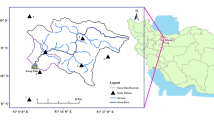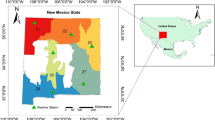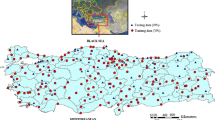Abstract
One of the most crucial issues in water and food security is to assess the impacts of climate change on virtual water content (VWC) and crop yield of agricultural products. The objective of this study is to efficiently predict the VWC patterns and yields of different crops under various climate change conditions using three data mining approaches including artificial neural network (ANN), genetic programming (GP), and support vector machine (SVM). The study region included the eastern provinces of Iran containing North Khorasan, Khorasan Razavi, South Khorasan, Sistan-Baluchestan (in a range of latitude from 25 to 40°N). Specifically, VWC and crop yields were estimated for both baseline period (1985–2005) and several climate change conditions including four time horizons (2030, 2050, 2070, and 2090) under RCPs 2.6, 4.5, and 8.5 based on the second generation Canadian Earth System Model (CanESM2). The data mining models were evaluated with the RMSE and NSE goodness-of-fit criteria. The results showed that the SVM model achieved the highest NSE and lowest RMSE values. It was also found that under the climate change conditions, VWC increased from 6 to 42%, while crop yield decreased from 8 to 53% for all products in the southern regions. An opposite trend was observed in the northern regions for wheat and barley with an increase from 12 to 72% for VWC and from 4 to 27% for the yield.







Similar content being viewed by others
References
Akbari-Alashti, H., Bozorg-Haddad, O., Fallah-Mehdipour, E., & Mariño, M. A. (2014). Multi-reservoir real-time operation rules: A new genetic programming approach. Proceedings of the Institution of Civil Engineers: Water Management, 167(10), 561–576. https://doi.org/10.1680/wama.13.00021
Allan, J. A. (1997). “Virtual water: a long term solution for water short Middle Eastern economies?” London: School of Oriental and African Studies, University of London, (September), 24–29.
Allen, R. G., Pereira, L. S., Raes, D., and Smith, M. (1998). “Crop evapotranspiration-Guidelines for computing crop water requirements.” FAO Irrigation and drainage, paper 56.
Arefinia, A., Bozorg-Haddad, O., & Chang, H. (2021). “The Role of Data Mining in Water Resources Management.” In Essential Tools for Water Resources Analysis, Planning, and Management (pp. 85–99). Springer, Singapore.
Arefinia, A., Bozorg-Haddad, O., Oliazadeh, A., & Loáiciga, H. A. (2020). Reservoir water quality simulation with data mining models. Environmental Monitoring and Assessment, 192(7), 1–13.
Asefa, T., Kemblowski, M., McKee, M., & Khalil, A. (2006). Multi-time scale stream flow predictions: The support vector machines approach. Journal of Hydrology, 318(1–4), 7–16.
Ba, H., Guo, S., Wang, Y., Hong, X., Zhong, Y., & Lio, Z. (2017). Improving ANN model in runoff forecasting by adding soil moisture input and using data preprocessing techniques. Hydrology Research. https://doi.org/10.2166/nh.2017.048
Banzhaf, W., Keller, R. E., and Francone, F. (1998). “Genetic programming: An introduction on the automatic evolution of computer programs and its applications machine code genetic programming and parallelism view project drone Squadron optimization view project.”
Behzad, M., Asghari, K., Eazi, M., & Palhang, M. (2009). Generalization performance of support vector machines and neural networks in runoff modeling. Expert Systems with Applications, 36(4), 7624–7629.
Bozorg-Haddad, O., Zolghadr-Asli, B., Sarzaeim, P., Aboutalebi, M., Chu, X., and Loáiciga, H. A. (2020). “Evaluation of water shortage crisis in the Middle East and possible remedies.“ Journal of Water Supply: Research and Technology—AQUA, 69(1), 85–98.
Bozorg-Haddad, O., Afshar, A., & Mariño, M. A. (2009a). Optimization of non-convex water resource problems by honey-bee mating optimization (HBMO) algorithm. Engineering Computations (swansea, Wales), 26(3), 267–280. https://doi.org/10.1108/02644400910943617
Bozorg-Haddad, O., Moradi-Jalal, M., Mirmomeni, M., Kholghi, M. K. H., & Mariño, M. A. (2009b). Optimal cultivation rules in multi-crop irrigation areas. Irrigation and Drainage, 58(1), 38–49. https://doi.org/10.1002/ird.381
Bozorg-Haddad, O., Solgi, M., & Loáiciga, H. A. (2017). Meta-heuristic and evolutionary algorithms for engineering optimization. John Wiley & Sons.
Cortes, C. and Vapnik, V. (1995). “Support-vector networks.” Machine Learning, Springer Science and Business Media LLC, 20(3), 273–297.”
Das, S. K., Samui, P., & Sabat, A. K. (2012). Prediction of field hydraulic conductivity of clay liners using an artificial neural network and support vector machine. International Journal of Geomechanics, 12(5), 606–611.
De Angelis, E., Metulini, R., Bove, V., & Riccaboni, M. (2017). Virtual water trade and bilateral conflicts. Advances in Water Resources, 110, 549–561.
Dobesch, H., Pierre, D., & Izabela, D. (2013). Spatial interpolation for climate data: the use of GIS in climatology and meteorology. Hoboken: Wiley.
IPCC, (2014). "Climate change 2014: Mitigation of climate change." Contribution of working Group III to the fifth assessment report of the intergovernmental panel on climate change, Cambridge University Press, Cambridge, United Kingdom and New York, NY.
Fallah-Mehdipour, E., Bozorg-Haddad, O., Beygi, S., & Mariño, M. A. (2011). Effect of utility function curvature of Young’s bargaining method on the design of WDNs. Water Resources Management, 25(9), 2197–2218. https://doi.org/10.1007/s11269-011-9802-5
Fang, S., Pei, H., Liu, Z., Beven, K., Wei, Z., Fang, S., Liu, Z., Wei, Z., Beven, K., & Pei, H. (2010). Water resources assessment and regional virtual water potential in the Turpan Basin, China. Water Resour Management, 24, 3321–3332.
Ghasemi, A., Heidarnejad, P., & Noorpoor, A. (2018). A novel solar-biomass based multi-generation energy system including water desalination and liquefaction of natural gas system: Thermodynamic and thermoeconomic optimization. Journal of Cleaner Production, 196, 424–437.
Habibifar, R., Khoshjahan, M., Saravi, V. S., & Kalantar, M. (2021). “Robust Energy Management of Residential Energy Hubs Integrated with Power-to-X Technology.” In 2021 IEEE Texas Power and Energy Conference (TPEC) (pp. 1–6). IEEE.
Han, C., Zhang, B., Chen, H., Wei, Z., & Liu, Y. (2019). Spatially distributed crop model based on remote sensing. Agricultural Water Management, 218, 165–173.
Hoekstra, A. (2003). ”Virtual water: An introduction .” virtual water trade 13.
Hoekstra, A. (2009). “Water security of nations: How international trade affects national water scarcity and dependency.” In “Threats to global water security” , pp. 27–36. Springer.
Hoekstra, A. Y., & Hung, P. Q. (2005). Globalisation of water resources: International virtual water flows in relation to crop trade. Global Environmental Change, 15(1), 45–56.
IPCC, (2014). "Climate change 2014: Impacts, adaptation and vulnerability. "Contribution of working Group II to the fifth assessment report of the intergovernmental panel on climate change, Cambridge University Press, Cambridge, United Kingdom and New York, NY.
IPCC. (2014b). Climate change 2014: Synthesis report. Cambridge University Press.
Jahandideh-Tehrani, M., Jenkins, G., & Helfer, F. (2020). A comparison of particle swarm optimization and genetic algorithm for daily rainfall-runoff modelling: A case study for Southeast Queensland, Australia. Optimization and Engineering. https://doi.org/10.1007/s11081-020-09538-3
Karim, S. H. T., Tofiq, T. A., Shariati, M., Rad, H. N., & Ghasemi, A. (2021). 4E analyses and multi-objective optimization of a solar-based combined cooling, heating, and power system for residential applications. Energy Reports, 7, 1780–1797.
Khu, S. T., Liong, S. Y., Babovic, V., Madsen, H., & Muttil, N. (2001). Genetic programming and its application in real-time runoff forecasting. Journal of the American Water Resources Association, American Water Resources Association, 37(2), 439–451.
Koza, J. R. (1994). Genetic programming: On the programming of computers by means of natural selection. Biosystems, MIT Press, 33(1), 69–73.
Levenberg, K. (1944). A method for the solution of certain non-linear problems in least squares. Quarterly of Applied Mathematics, 2(2), 164–168.
Liu, J., & Savenije, H. H. G. (2008). Food consumption patterns and their effect on water requirement in China. Hydrology and Earth System Sciences, 12(3), 887–898.
Mahjoobi, J., & Adeli Mosabbeb, E. (2009). Prediction of significant wave height using regressive support vector machines. Ocean Engineering, 36(5), 339–347.
Maity, R., Bhagwat, P. P., & Bhatnagar, A. (2010). Potential of support vector regression for prediction of monthly streamflow using endogenous property. Hydrological Processes, 24(7), 917–923.
Malik, A., and Bhagwat, A. (2021). “Modelling groundwater level fluctuations in urban areas using artificial neural network.” Groundwater for Sustainable Development, 12, 100484.
Marquardt, D. W. (1963). An algorithm for least-Squares estimation of nonlinear parameters. Journal of the Society for Industrial and Applied Mathematics, Society for Industrial & Applied Mathematics (SIAM), 11(2), 431–441.
Mohandes, M. A., Halawani, T. O., Rehman, S., & Hussain, A. A. (2004). Support vector machines for wind speed prediction. Renewable Energy, 29(6), 939–947.
Nabavi, M., Nazarpour, V., Alibak, A. H., Bagherzadeh, A., & Alizadeh, S. M. (2021b). “Smart tracking of the influence of alumina nanoparticles on the thermal coefficient of nanosuspensions: application of LS-SVM methodology.” Applied Nanoscience, 1–16.
Nabavi, M., Elveny, M., Danshina, S. D., Behroyan, I., & Babanezhad, M. (2021a). Velocity prediction of Cu/water nanofluid convective flow in a circular tube: Learning CFD data by differential evolution algorithm based fuzzy inference system (DEFIS). International Communications in Heat and Mass Transfer, 126, 105373.
Niu, W. J., and Feng, Z. K. (2021). “Evaluating the performances of several artificial intelligence methods in forecasting daily streamflow time series for sustainable water resources management.” Sustainable Cities and Society, 64, 102562.
Orouji, H., Bozorg-Haddad, O., Fallah-Mehdipour, E., & Mariño, M. A. (2014). Extraction of decision alternatives in project management: Application of hybrid PSO-SFLA. Journal of Management in Engineering, 30(1), 50–59. https://doi.org/10.1061/(ASCE)ME.1943-5479.0000186
Pongratz, J., Lobell, D. B., Cao, L., & Caldeira, K. (2012). Crop yields in a geoengineered climate. Nature Climate Change, 2(2), 101–105.
Quan, Q., Gao, S., Shang, Y., & Wang, B. (2021). “Assessment of the sustainability of Gymnocypris eckloni habitat under river damming in the source region of the Yellow River”. The Science of the total environment, 778, 146312.
Sabbaghpour, S., Naghashzadehgan, M., Javaherdeh, K., & Bozorg-Haddad, O. (2012). HBMO algorithm for calibrating water distribution network of Langarud city. Water Science and Technology, 65(9), 1564–1569.
Salehi, A., Karbassi, A., Ghobadian, B., Ghasemi, A., & Doustgani, A. (2019). “Simulation process of biodiesel production plant.” Environmental Progress & Sustainable Energy, 38(6), e13264.
Salmoral, G., & Yan, X. (2018). Food-energy-water nexus: A life cycle analysis on virtual water and embodied energy in food consumption in the Tamar catchment, UK. Resources, Conservation and Recycling, 133, 320–330.
Sarzaeim, P. and Bozorg-Haddad, O. (2015). "Runoff prediction under climate change conditions: artificial neural network." Proceeding of the third international conference on advances in civil, structural and environmental engineering, Zurich, Switzerland, 10–11 October.
Sarzaeim, P., Muñoz-Arriola, F., and Jarquin, D. (2020). “Analytics for climate-uncertainty estimation and propagation in maize-phenotype predictions.” American Society of Agricultural and Biological Engineers. In 2020 ASABE Annual International Virtual Meeting (p. 1).
Sarzaeim, P., Bozorg-Haddad, O., Bozorgi, A., & Loáiciga, H. A. (2017). Runoff projection under climate change conditions with data-mining methods. Journal of Irrigation and Drainage Engineering, 143(8), 04017026.
Sarzaeim, P., Bozorg-Haddad, O., Zolghadr-Asli, B., Fallah-Mehdipour, E., & Loáiciga, H. A. (2018). Optimization of run-of-river hydropower plant design under climate change conditions. Water Resources Management, 32(12), 3919–3934.
Savic, D. A., Walters, G. A., & Davidson, J. W. (1999). A genetic programming approach to rainfall-runoff modelling. Water Resources Management, Kluwer Academic Publishers, 13(3), 219–231.
Secci, D., Patriche, C. V., Ursu, A., & Sfîcă, L. (2010). Spatial interpolation of mean annual precipitations in Sardinia. A comparative analysis of several methods. Geographia Technica, 9(1), 68–75.
Sepahvand, R., Safavi, H. R., & Rezaei, F. (2019). Multi-objective planning for conjunctive use of surface and ground water resources using genetic programming. Water Resources Management, 33(6), 2123–2137.
Shayesteh, A. A., Koohshekan, O., Ghasemi, A., Nemati, M., & Mokhtari, H. (2019). Determination of the ORC-RO system optimum parameters based on 4E analysis; Water–Energy-Environment nexus. Energy Conversion and Management, 183, 772–790.
Sivapragasam, C., Vasudevan, G., & Vincent, P. (2007). Effect of inflow forecast accuracy and operating time horizon in optimizing irrigation releases. Water Resources Management, 21, 933–945.
Talebizadehsardari, P., Ehyaei, M. A., Ahmadi, A., Jamali, D. H., Shirmohammadi, R., Eyvazian, A., ... & Rosen, M. A. (2020). “Energy, exergy, economic, exergoeconomic, and exergoenvironmental (5E) analyses of a triple cycle with carbon capture.” Journal of CO2 Utilization, 41, 101258.
Vapnik, V. (1998). Statistical learning theory. John Wiley.
Wichelns, D. (2005). The virtual water metaphor enhances policy discussions regarding scarce resources. Water International, 30, 428–437.
Yang, Y., Li, Y., Yao, J., Iglauer, S., Luquot, L., Zhang, K., Wang, Z. (2020). Dynamic Pore‐Scale Dissolution by CO2‐Saturated Brine in Carbonates: Impact of Homogeneous Versus Fractured Versus Vuggy Pore Structure. Water resources research, 56(4).
Yang, H., Wang, L., Abbaspour, K. C., & Zehnder, A. J. B. (2006). Virtual water trade: An assessment of water use efficiency in the international food trade. Hydrology and Earth System Sciences, 10, 443–454.
Zhang, B., Xu, D., Liu, Y., Li, F., Cai, J., & Du, L. (2016). Multi-scale evapotranspiration of summer maize and the controlling meteorological factors in north China. Agricultural and Forest Meteorology, 216, 1–12. https://doi.org/10.1016/j.agrformet.2015.09.015
Zhang, K., Chao, L., Wang, Q., Huang, Y., Liu, R., Hong, Y., & Ye, J. (2019a). Using multi-satellite microwave remote sensing observations for retrieval of daily surface soil moisture across China. Water Science and Engineering, 12(2), 85–97.
Zhang, K., Wang, Q., Chao, L., Ye, J., Li, Z., Yu, Z., & Ju, Q. (2019b). Ground observation-based analysis of soil moisture spatiotemporal variability across a humid to semi-humid transitional zone in China. Journal of Hydrology (amsterdam), 574, 903–914.
Zhao, Q., Liu, J., Khabarov, N., Obersteiner, M., and Westphal, M. (2014). “Ecological informatics impacts of climate change on virtual water content of crops in China.” Ecological Informatics, Elsevier B.V., 19, 26–34.
Zhou, H. (2020). “Artificial Neural Network.” In Learn Data Mining Through Excel (pp. 163–187). Apress, Berkeley, CA.
Zolghadr-Asli, B., Bozorg-Haddad, O., & Chu, X. (2019a). Effects of the uncertainties of climate change on the performance of hydropower systems. Journal of Water and Climate Change, 10(3), 591–609.
Zolghadr-Asli, B., Bozorg-Haddad, O., Sarzaeim, P., & Chu, X. (2019b). Investigating the variability of GCMs’ simulations using time series analysis. Journal of Water and Climate Change, 10(3), 449–463.
Acknowledgements
The authors thank Iran’s National Science Foundation (INSF) for its financial support for this research.
Author information
Authors and Affiliations
Corresponding author
Ethics declarations
Conflict of interest
The author declared that there is no conflict of interest.
Additional information
Publisher's Note
Springer Nature remains neutral with regard to jurisdictional claims in published maps and institutional affiliations.
Rights and permissions
About this article
Cite this article
Arefinia, A., Bozorg-Haddad, O., Ahmadaali, K. et al. Estimation of geographical variations in virtual water content and crop yield under climate change: comparison of three data mining approaches. Environ Dev Sustain 24, 8378–8396 (2022). https://doi.org/10.1007/s10668-021-01788-0
Received:
Accepted:
Published:
Issue Date:
DOI: https://doi.org/10.1007/s10668-021-01788-0




